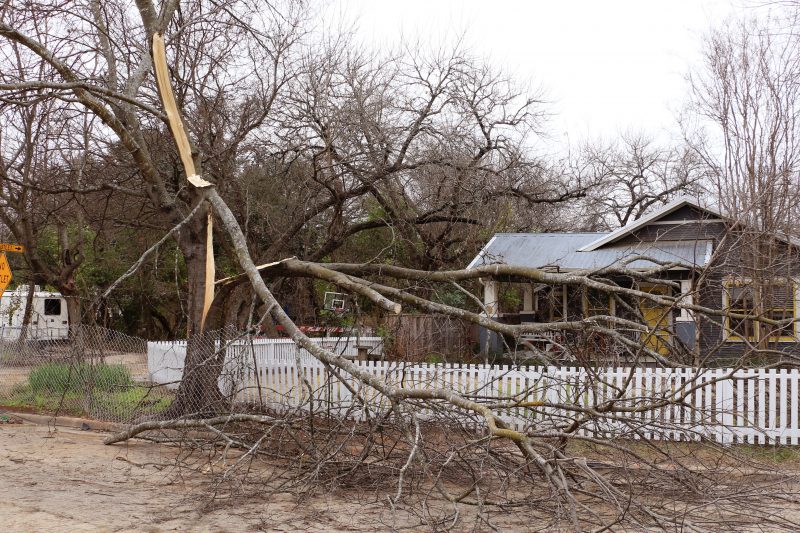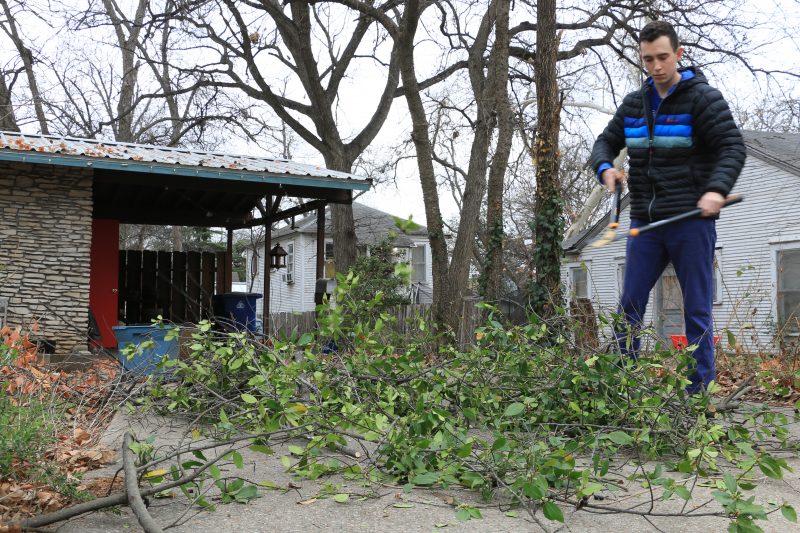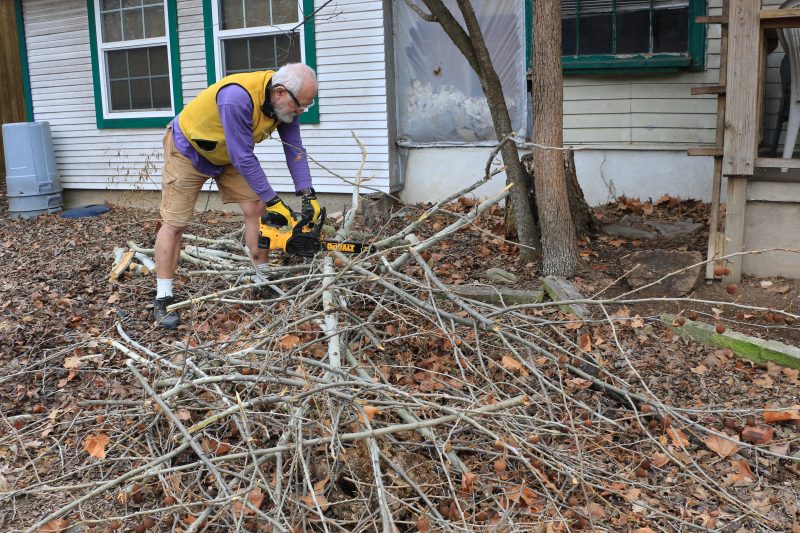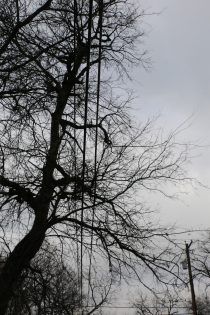Following Ice Storm, Arborists Say Focus on Better Tree Placement, Care
By Keaton Peters
Reporting Texas

Downed tree limbs block streets and create hazards in the Hyde Park neighborhood Friday, following the freeze that wreaked havoc in Austin, Texas. Lauren Nelson/Reporting Texas
As the last of the ice dripped off trees and power began to come back on after the ice storm last week, residents such as Chris Haley, 50, cleared fallen limbs, one by one, from Austin’s Hyde Park neighborhood.
“It’s just sad. This tree cover is so important,” Haley said, standing beside a pile of branches he helped cut from a limb that fell in his neighbor’s backyard.
The block where Haley lives lost power early Wednesday morning and got it back at about 10:30 p.m., which was much sooner than some Austinites. As of Monday morning, more than 26,000 customers of Austin Energy were still without power.
Falling limbs and sagging power lines have been the leading cause of power outages.
In addition to the loss of power for many residents, the city’s urban tree canopy suffered significant damage, and many Austinites and area arborists have been left questioning what the city can do better to protect both power lines and the renowned urban tree canopy.
Extensive damage

Sean Moothart trims fallen branches outside his residence Friday after many were felled by the recent freeze. He had moved his car minutes before a large branch fell where it had been parked. Lauren Nelson/Reporting Texas
In Hyde Park, and much of Austin, fallen tree limbs fell on power lines, sidewalks, yards and parked cars.
“I got pretty lucky,” said Sean Moothart, a Hyde Park resident and student at the University of Texas who moved his car minutes before a large branch fell where it had been parked.
“I’ve lived through two winter storms at this point,” he said, looking around at the damage in his neighborhood.
“It’s very sad to see (the damage) firsthand,” he added.
Benjamin Bertram is the program director and lead arborist at TreeFolks, a nonprofit that partners with Austin Energy to give trees to homeowners to provide shade that can lower electricity usage.
Not all trees suffered equally in the storm, Bertram said. Trees that do not shed their leaves in winter, such as Live Oaks and Ashe Junipers, are more vulnerable to ice accumulation. The leaves provide greater surface area for heavy ice to accumulate and weigh down the trees.
Austin’s majestic and mature live oaks were especially hard hit, Bertram said.
Seeing so many damaged trees, triggered “a sense of loss,” Bertram said.
Tree trimming policy
Austin Energy, the publicly owned utility that provides electricity to Austin and environs, is responsible for trimming trees to prevent them from damaging power lines.
Some have questioned Austin Energy’s tree trimming practices in light of the storm. Austin City Council Member Mackenzie Kelly called Friday for an audit of Austin Energy’s vegetation management practices and its response to the storm.
“During the February 2023 freeze, our community needed answers and didn’t receive them,” Kelly said in a prepared statement.

Elton Richards, senior vice president of Field Operations for Austin Energy, answers questions about the many power outages throughout the city during a press conference in Austin, Texas, on Feb. 2, 2023. Richards said the power outages were “not a vegetation management issue.” Keaton Peters/Reporting Texas
Austin Energy has a backlog of trees needing trimming, and it will take another three years to get caught up, said Elton Richards, senior vice president of Field Operations for Austin Energy. Richards blamed the backlog on a former city policy that “restricted the trimming on the trees down to an unsustainable manner.”
The policy, which ended in 2019, had stopped Austin Energy from trimming trees back more than four feet from the power lines, Richards said. The “industry standard” is 15 feet, and the forestry division has been working to catch up and get back to the 15-foot standard, he added.
“Three years ago, this would have been even worse than it is now,” Richards said.
Austin Energy first prioritizes areas that present a wildfire risk and where outages frequently occur for trimming, Richards said.

Julian Henry trims fallen branches in the Hyde Park neighborhood of Austin, Texas. Lauren Nelson/Reporting Texas
When trees needing to be cut are located on private property, homeowners are notified of Austin Energy’s plans to trim them.
Homeowners do have the right to “dispute” tree trimming plans, Austin Energy spokesperson Matt Mitchell said.
“We really need help from the community to allow us to do better vegetation management,” Austin Energy General Manager Jackie Sargent said Thursday during a press conference.
Austin Energy will complete an “after action review” of the storm, Sargent said, at which point, Austin Energy may revise vegetation management policies.
Tree placement and care
Almost 36% of Austin is covered in tree canopy, according to data from the city. Bertram explained that in addition to temperature reduction and energy savings, trees aid in fighting climate change by sequestering carbon dioxide, and they help improve flood control, water filtration and air quality.

Trees growing perilously close to electrical wires line the streets of Austin, Texas. This is one of the problems that contributed to the downing of power lines during the recent ice storm. Lauren Nelson/Reporting Texas
As Austin continues to balance growing the urban tree canopy with providing resilient electrical service, Bertram said tree placement is critical to avoiding another event like this in the future.
“Trees that grow large need to be about 50 feet away from those power lines,” Bertram said.
Rebecca Johnson, a certified arborist based in the Wells Branch neighborhood just north of Austin, told Reporting Texas that, “if over the 40, 50 or 60-year lifespan of these trees, we had been pruning them better, they probably would have done better,” but she added that even with the best care, trees are “not made to have that kind of weight pushing down on them.”
“There are things that we can do to help our trees become more resilient,” Bertram said, urging homeowners to work with certified arborists to find the right tree for the right spot, prune and water trees regularly, avoid compacting the soil and assure trees have adequate mulch and nutrients.

Public education about better tree selection and pruning practices might have lessened the impact of the recent ice storm on Austin’s trees, said arborist Rebecca Johnson. Lauren Nelson/ Reporting Texas
To ensure the next ice storm does not cause so many power outages, more “public education about where to plant trees could make all the difference,” Johnson said.
“Its a balancing act because we know trees provide a lot of benefits to human health,” Johnson said. “I’m thankful that I’m not a utility forester having to make those decisions (about what trees to trim and cut down) because it’s not easy.”